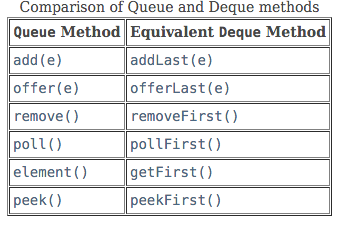Outline
- Linear Data Structure
- Queue
- Stack
- Hash
- Tree Data Structure
- Heap
Definition
Data Structure is a way to organize data. It provides some methods to handle data stream, e.g. insert, delete, etc.
Queue
First In First Out
The difference between stacks and queues is in removing. In a stack we remove the item the most recently added; in a queue, we remove the item the least recently added.
In Java, there is a Queue Interface. Implemented by LinkedList, ArrayDeque, etc.

add: O(1) remove: O(1) peek: O(1)
Queue is often used when elements need to be processed First In First Out.
1) When a resource is shared among multiple consumers. Examples include CPU scheduling, Disk Scheduling.
2) When data is transferred asynchronously (data not necessarily received at same rate as sent) between two processes. Examples include IO Buffers, pipes, file IO, etc.
3) BFS
Example:
Implementing Queue Using Two Stacks
Priority Queue
Priority Queue is an extension of queue with following properties.
1) Every item has a priority associated with it.
2) An element with high priority is dequeued before an element with low priority.
3) If two elements have the same priority, they are served according to their order in the queue.
In Java, PriorityQueue is a class.
- An unbounded priority queue based on a priority heap. The elements of the priority queue are ordered according to their natural ordering, or by a
Comparatorprovided at queue construction time, depending on which constructor is used. - Not thread safe.
Implementation of Priority Queue:
1. Use array
class node {
public int value;
public int priority;
}
2. Use heap
Application of Priority Queue
1) CPU Scheduling
2) Graph algorithms like Dijkstra’s shortest path algorithm, Prim’s Minimum Spanning Tree, etc
3) All queue applications where priority is involved.
Example
Deque (Double Ended Queue)
Allow insertion and deletion at both ends.
In Java, there is a Deque Interface. Implemented by ArrayDeque, LinkedList, ConcurrentLinkedDeque, LinkedBlockingDeque.
ArrayDeque:
- Resizable-array implementation of the Deque interface; have no capacity restrictions.
- Not thread-safe; Do not support concurrent access by multiple threads.
- Null elements are prohibited.
- Faster than Stack when used as a stack, and faster than LinkedList when used as a queue.
- Most ArrayDeque operations run in amortized constant time. Exceptions include remove, removeFirstOccurrence, removeLastOccurrence, contains, iterator.remove(), and the bulk operations, all of which run in linear time.
LinkedList:
- Doubly-linked list implementation of the List and Deque interfaces.
- Permits all elements (including null).
- Not thread-safe. If multiple threads access a linked list concurrently, and at least one of the threads modifies the list structurally, it must be synchronized externally.
ConcurrentLinkedDeque:
- An unbounded concurrent deque based on linked nodes.
- Concurrent insertion, removal, and access operations execute safely across multiple threads.
- An appropriate choice when many threads will share access to a common collection. Like most other concurrent collection implementations, this class does not permit the use of null elements.
- Unlike in most collections, the size method is NOT a constant-time operation.



Deque Application
Deque is often used in the problems where elements need to be removed and or added both ends.
Example: Sliding Window Maximum
Deque Implementation
A Deque can be implemented either using a doubly linked list or circular array. In both implementation, we can implement all operations in O(1) time.